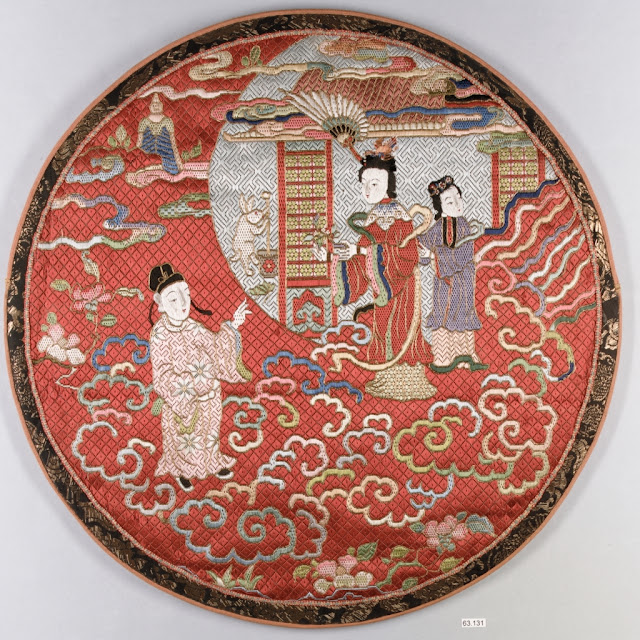Chikan embroidery of Lucknow
The chikan or chikankari is a delicate and subtle embroidery done in white thread on a white background, though sometimes yellowish silk is also used in addition to the white thread. The embroidery is characterized by the contrasts in texture provided by the delicacy of fine jali work and heavily embossed stitches on fine fabrics. It is amazingly beautiful with its delicate patterns and the excellence of execution. Noor Jehan, wife of the Mughal emperor Jehangir is said to have introduced it to Lucknow. The earliest samples of chikan embroidery that have survived are from the 19th century. It is not clear where the word chikan came from. It might come from Persian where it means "embroidery", or it could be of Bengali origin where it means "very fine thing".
Traditional Chinese embroidery
Mirror Case with Lunar Scene, Qing dynasty, 19th century. Embroidered silk gauze. The Metropolitan Museum of Art
Embroiery in China has a long history dating back to the invention of silk four thousand years ago. It is known that the ceremonial garments of the tribal leaders of that time were decorated with embroidered patterns of the sun, the moon, stars, weed, fire and other auspicious symbols. To date the earliest survived embroidery works are the two 4th century BC pieces unearthed from the Chu Tombs. The patterns of dragon, phoenix, tiger and beast embroidered on silk appear natural and lifelike which gives full credit to the achivements of embroidery art in the ancient China.
The art of embroidery further developed during Qin and Han dynasties. Embroideries of that time represent the artistic style as well as the high level of embroidery and mostly have patterns of ripple-like clouds, soaring phoenix, galloping holy beasts, ribbon-shaped flowers, geometric figures etc, using basically locking method with neat stitching, compact compostion and smooth lines.
Souvenirs from Russia: Khokhloma
 Khokhloma tableware, The Golden Khokhloma Museum, Semyonov
Khokhloma tableware, The Golden Khokhloma Museum, Semyonov Japanese hand embroidery
photo source
Until 1980, when pieces of Japanese embroidery were exhibited at the national seminar of the Embroiderers' Guild of America in DalIas, Texas, its embroidery was hardly known outside Japan. One of the things that makes Japanese embroidery unique is the fact that it uses silk threads that come in up to 500 different colors. The pattern, the season and the age group of the person who will use the finished product all come into consideration when choosing the right colors.
Souvenirs from Vietnam: embroidery
If you want to bring a meaningful and beautiful souvenir from Vietnam think about buying an embroidered picture. They are rather costly but one doesn't expect a piece of art to be cheap and those embroideries are indeed works of art. There are many motifs to choose from: animals and still life, landscapes and Vietnamese countryside, portraits and flowers.
Made for Maharajahs: the pearl carpet of Baroda
The most incredible carpet ever created by human hand is the famous Pearl Carpet of Baroda. It gets its name from the Maratha Princely State of Baroda, one of the four Princely States of the Maratha Confederacy, that was ruled by the Gaekwar dynasty since 1740. The carpet was made in 1865 and it took embroiderers and jewelers more than three years to create this masterpiece. The then Maharajah of Baroda, Gaekwar Khande Rao, ordered the carpet to fulfill his vow to cover the tomb of the Prophet Muhammad at Medina.
Subscribe to:
Comments (Atom)




